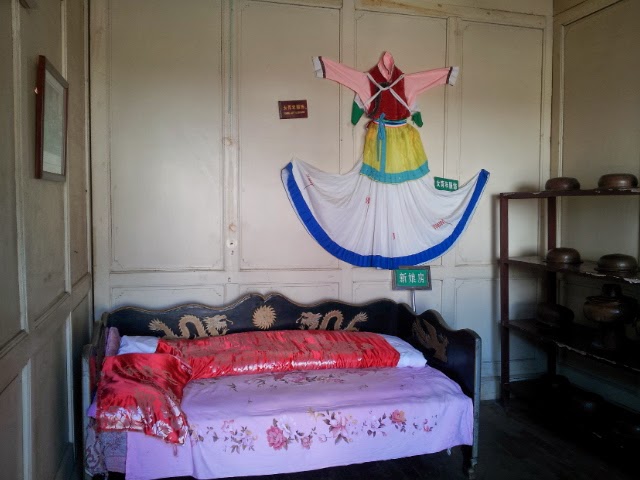Peacock Dance (孔雀舞)
Directed and choreographed by Liping Yang (楊麗萍), "Dynamic Yunnan" is one of the best performances I have seen. The peacock dance is one of the most wide-spread ancient dances of the Dai ethnic group. The peacock symbolizes good luck, happiness, beauty and honesty.
DAY 13 - September 21, 1013 - Ethnic Minorities
China is composed of 56 ethnic minority groups (中國少数民族):
| 1. Han (漢族) | 20. She (畲族) | 39. Tajik (塔吉克族) |
| 2. Zhuang (壮族) | 21. Lisu (傈僳族) | 40. Achang (阿昌族) |
| 3. Man (滿族) | 22. Gelao (仡佬族) | 41. Pumi (普米族) |
| 4. Hui (回族) | 23. Dongxiang (東乡族) | 42. Ewenki (鄂温克族) |
| 5. Miao (苗族) | 24. Gaoshan (高山族) | 43. Nu (怒族) |
| 6. Uygur (維吾尔族) | 25. Lahu (拉祜族) | 44. Gin (京族) |
| 7. Tujia (土家族) | 26. Sui (水族) | 45. Jino (基诺族) |
| 8. Yi (彝族) | 27. Va (佤族) | 46. Deang (德昂族) |
| 9. Mongol (蒙古族) | 28. Naxi (納西族) | 47. Bonan (保安族) |
| 10. Tibetan (藏族) | 29. Qiang (羌族) | 48. Russ (俄罗斯族) |
| 11. Buyei (布依族) | 30. Tu (土族) | 49. Yugur (裕固族) |
| 12. Dong (侗族) | 31. Mulao (仫佬族) | 50. Uzbek (烏茲別克族) |
| 13. Yao (瑶族) | 32. Xibe (錫伯族) | 51. Monba (門巴族) |
| 14. Chosen (朝鮮族) | 33. Kirgiz (柯尔克孜族) | 52. Orogen (鄂伦春族) |
| 15. Bai (白族) | 34. Daur (達斡尔族) | 53. Derung (獨龍族) |
| 16. Hani (哈尼族) | 35. Jingpo (景颇族) | 54. Tatar (塔塔尔族) |
| 17. Kazak (哈萨克族) | 36. Maonan (毛南族) | 55. Hezhen (赫哲族) |
| 18. Li (黎族) | 37. Salar (撒拉族) | 56. Lhoba (珞巴族) |
| 19. Dai (傣族) | 38. Blang (布朗族) |
Han is the major group. I belong to the Han. Many of the ethnic groups are in Yunnan province.
Yunnan Nationalities Village
This park allows you to learn more about the ethnic minorities.
Naxi
Having a population of 308 839, this ethnic group is mainly concentrated in Lijiang. In order to fit with the natural environment (terrain, climate and materials), houses are built in different styles.
The Dongba Script:
The Naxi created the Dongba pictographic writing which consists of about 1,300 characters. The pictographs have been used by the Dongba priests for over a thousand years.
Mosuo
Mosuo (摩梭) is a subgroup of the Naxi. The dwellings are stilted courtyard house built with pine wood. The architecture consists of four 2-stories buildings: the main building "Grandmother's Room" (分正房), the scripture hall (經堂), the "Flower Building" (花楼) and the gate tower (門楼).
In this matriarchal community, the grandmother is the head of the family. Her room becomes the center of the family activities.
The most famous aspect of the Mosuo culture is their practice of "Walking Marriages (走婚)”. Women are free to choose their sexual partners. The marriageable girl has her own private bedroom. She who is interested in a particular man will invite him to spend the night together in her room. At night-time, her lover climbs through the window to meet her. Early in the next morning, he returns to his own home. The pairing may be long term. However, couples do not live together or get married. The man will continue to live with and be responsible of his family and the woman, her family. If a child is born, he/ she will be raised in the mother's family and take her family name. The father may have little or no responsibility for his offspring. Some children do not know who their father is.
Va (Wa)
The population is approximately 360 000 people. The dwelling is made out of bamboo, wood and grass. It has 2 floors. The upper story is for living and the lower story is for entertainment. There is no furniture. The people sleep on the floor. The house has a balcony.
In the village, there is a Cowhead Square where the cow slaughtering ritual is performed. There are 2 stone figures standing at the entrance: one male named "Muyiji" (木依吉) and one female, "Ayie" (阿依娥). They represent the ancestors which the Va people worship. At the center of the square, there is a cow horn representing the center of the village. The Cowhead Square is a showcase of the tribe's beliefs in animism and immortality of the soul.
Singing and dancing are the main entertainment. The principal musical instrument is the wooden drum. It is played either for worshipping the gods and the ancestors or for a big celebration.
Derung
This ethnic group has a population of about 6000 people. The dwelling is on a tree. The little wooden house has a simple architecture which consists of 4 walls only.
Sources: en.ynta.gov.cn, www.ynmzc.cc, cctv.cntv.cn/lm/journeysintime/special/naxi_people/


















































No comments:
Post a Comment